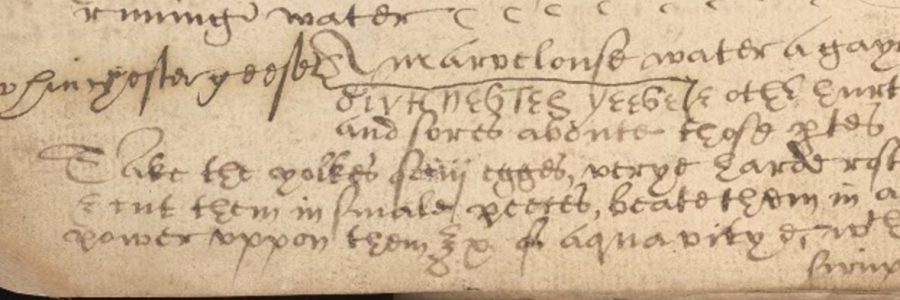
A Tudor Medical Manuscript: Winchester Geese, Bullet Extractors, and Cataplasms from the Court of Henry VIII
Followers of the Curious Cures in Cambridge Libraries project who also listen BBC Radio 4 comedy show The Unbelievable Truth may have heard some very familiar material in this week’s episode – in particular, so-called ‘Winchester Geese’, who make an appearance in Cambridge, University Library, MS Dd.6.9.

as well as syrups and waters for the head, breast, stomach and liver
(Cambridge, University Library, MS Dd.6.9, ff. 33v-34r)
Containing medical recipes in English and Latin written in cursive scripts and featuring no illustrations, this may seem like an inconspicuous manuscript at first sight. However, in cataloguing the manuscript, we have uncovered tantalising details about its origin and provenance. Whereas librarians and scholars have long dated the manuscript to the fifteenth century, this blogpost explores evidence that it was produced much later, namely in the later part of the reign of Queen Elizabeth I (r. 1558–1603). Its contents are connected with notable medical, literary and royal figures from the sixteenth century. Moreover, it appears that the manuscript was used well into the seventeenth century, perhaps during the English Civil War.

(Cambridge, University Library, MS Dd.6.9, f. 31v)

Several subtle clues for the manuscript’s date of production can be found among its medical recipes. One example is ‘Dr Stevens Water’, a recipe involving Gascony wine mixed with herbs and spices such as anise and caraway seeds, camomile, cinnamon, cloves, fennel, galangal, ginger, lavender, marjoram, mint, nutmeg, pellitory, red roses, rosemary, sage, and thyme. The presence of this recipe provides an indication for the manuscript’s dating, since other copies of it were predominantly if not exclusively copied or printed in the sixteenth and seventeenth centuries. For example, it is included in the 1578 edition of John Partridge’s The Treasurie of Commodious Conceits and Hidden Secrets, Hugh Plat’s Delightes for Ladies (1602), and the anonymous Closet for Ladies and Gentlewomen (1608). These other sources also give use more details about the recipe. While our manuscript does not state its purpose, other copies explain that the water not only is a cure-all but also offers longevity. As some versions tell, Dr Stephens – if he ever existed – lived close to the age of one hundred by using the water on himself. Having kept the recipe a secret for most of his life, he shared it with the Archbishop of Canterbury shortly before his death.

(Cambridge, University Library, MS Dd.6.9, f. 48v)
Another hint about the manuscript’s date is a recipe with the title ‘A marvelouse water agaynst the Winchester Geese’. The latter two words are encrypted with letters from the Greek alphabet, perhaps because they were considered taboo. ‘Winchester Geese’ was a term used for sex workers who were licensed by the Bishop of Winchester to work within the Manor of Southwark, later known as the Liberty of the Clink. The term was also synonymous with venereal disease, to which this recipe probably refers. According to Green’s Dictionary of Slang, the term was first used in the second half of the sixteenth century.
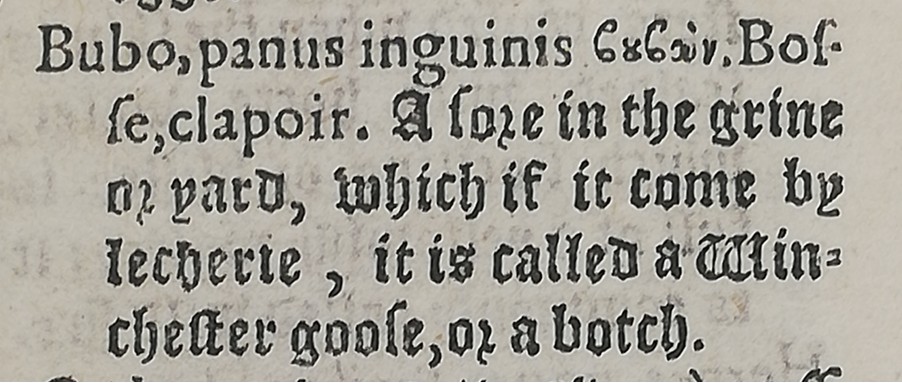
(Cambridge, University Library, Bb*.6.8(F))
One of its earliest occurrences is inThe Nomenclator, or, Remembrancer of Adrianus Iunius (London, 1586) which states that a ‘sore in the groin or penis, which if it comes from lechery, is called a Winchester Goose’. Today, the term is best known through William Shakespeare (1564–1616) who in King Henry VI: Part I (1591) has Humphrey, Duke of Gloucester, mock Henry Beaufort, Bishop of Winchester, with the exclamation ‘Winchester goose!‘.

(Cambridge, University Library, MS Dd.6.9, f. 81r)
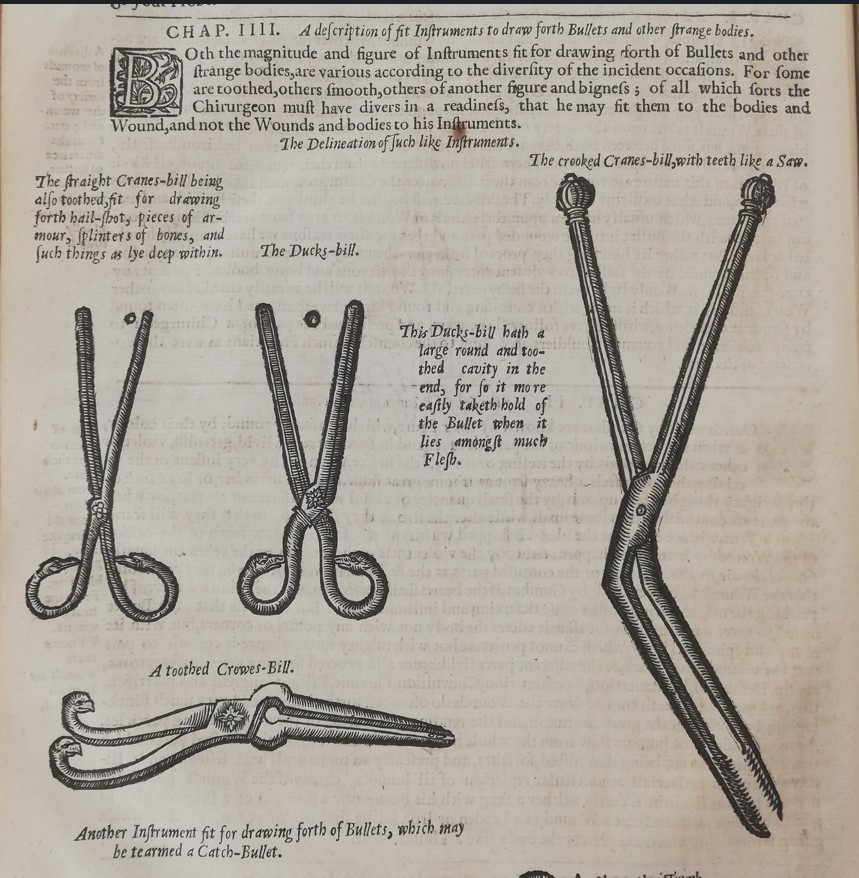
trans. George Baker and Thomas Johnson (London: Richard Cotes and Willi: Du-gard, 1649)
(Cambridge, University Library, Rel.a.64.1)
A third subtle clue about the manuscript’s date can be found in a tract on treating gunshot wounds, a genre of medical writing that started to develop at the end of the fifteenth century, when the use of firearms became more common in military conflicts in Europe. The English tract in our manuscript recommends using forceps-like instruments called ‘crow-bills’ and ‘goose-bills’ for removing bullets from wounds, referring to the similarities between their shapes and those of birds’ beaks. The reference to these instruments is useful because bullet extractors came into existence only in the early sixteenth century.

(Cambridge, University Library, MS Dd.6.9, f. 56r)
Aside from subtle references, the manuscript mentions various identifiable persons who can help us date the manuscript more precisely. For example, on one page a scribe has copied medical notes that are said to have been ‘gathered in redinge over Jherome of Brunswike’. This undoubtedly refers to the German surgeon Jerome of Brunswick [Hieronymus Brunschwig] (c. 1450–1512) whose book on surgery was printed in German as early as 1497 (Das buch der cirurgia: hantwirckung der wundarztny), but was published in an English translation only in 1525 (The Noble Experyence of the Vertuous Handy Warke of Surgeri).
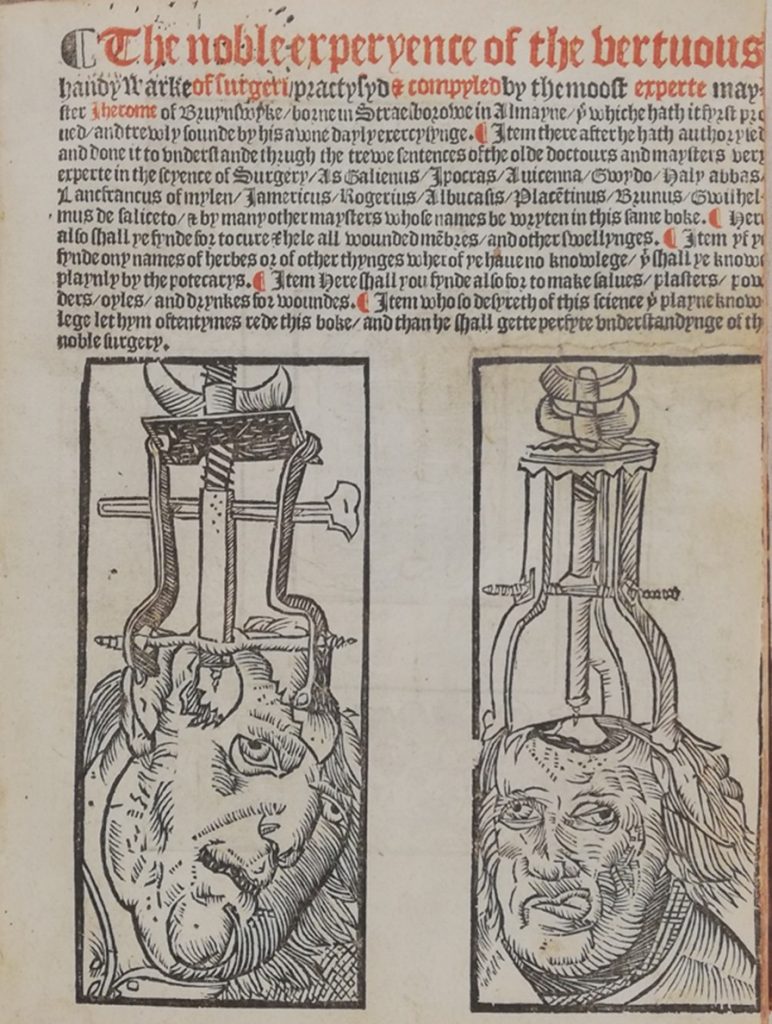
(London: Peter Treveris, 1525)
(Cambridge, University Library, Sel.3.149)
While it is possible that the scribe read Brunswick’s work on surgery in German, other works cited in the manuscript only came into existence in the sixteenth century. One such later text concerns a recipe for making a cataplasm – a soft moist mass that was spread on a cloth and then applied to the skin – that can lessen pain and soften stiffness and is said to have been made for the ‘Kinges Maiestie’. Although the name of the king in question is not given, he can be no other than Henry VIII (r. 1509–1547).

(Cambridge, University Library, MS Dd.6.9, f. 67r)
The very same cataplasm recipe is included in a collection of recipes originating with Henry and his royal physicians. This collection survives uniquely in London, British Library, Sloane MS 1047, a manuscript that was compiled in the 1540s –possibly during Henry’s lifetime. Interestingly, it claims that the cataplasm was made at Hampton Court and not for the king, as our manuscript has it, but by him (the Sloane manuscript attributes more than thirty recipes to Henry, suggesting that he actively collaborated with his physicians in devising cures for his leg ailments). The Sloane manuscript also contains two other cataplasms that feature in MS Dd.6.9. While the latter does not attribute them to any medical practitioners, the Sloane manuscript states that one was made by Henry VIII, this time at St James’s Palace, and the other by the royal physician William Butts (c. 1486–1545). The occurrence of these three cataplasms in our manuscript, then, strongly suggests that it was produced after 1540.
But it is possible to push the date of the manuscript’s production even further forward in time. For this, we need to look closely at previously unidentified texts on the manuscript’s final page. Due to the presence of heavy dirt on the page, the Catalogue of the Manuscripts preserved in the Library of the University of Cambridge (1856) considered these texts illegible.
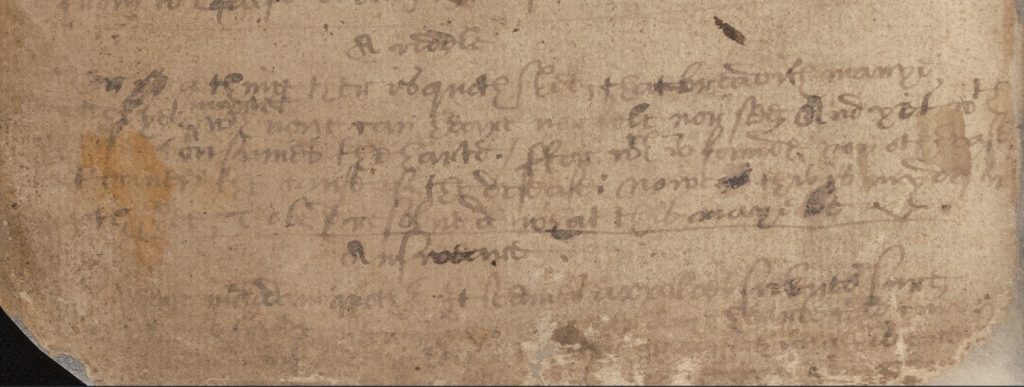
(Cambridge, University Library, MS Dd.6.9, f. 86v)
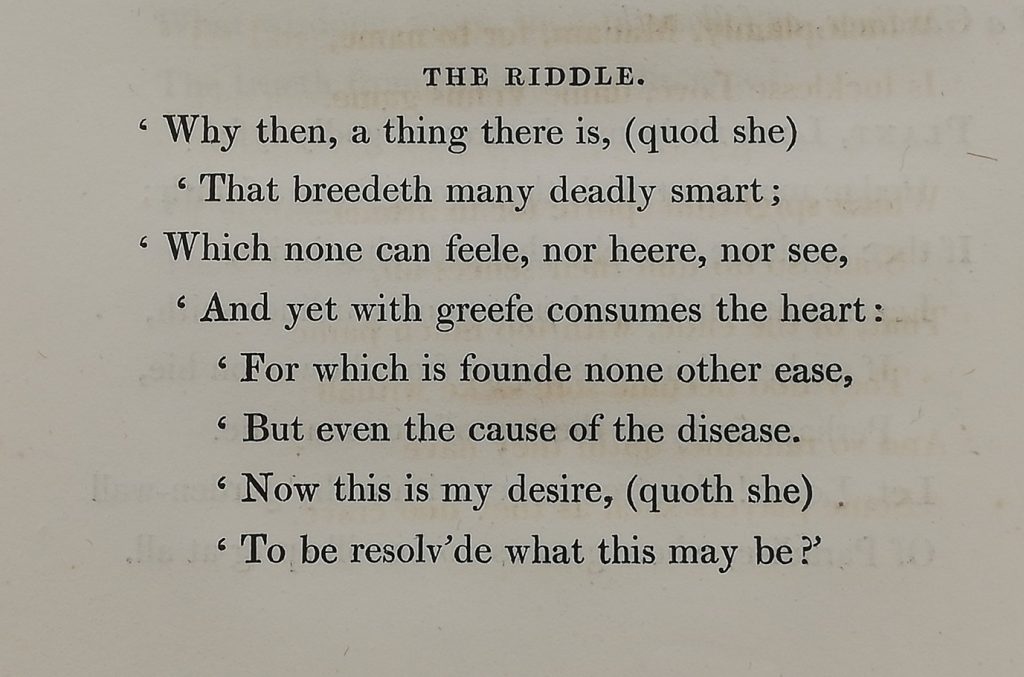
(Cambridge, University Library, XIV.2.14)
However, upon closer inspection and after careful cleaning of the page by Conservator Marina Pelissari, we have been able to read and identify them after all. Surprisingly, the page does not contain medical recipes but extracts from A Floorish vpon Fancie (London: Richard Jhones, 1577 and 1582), a printed compilation of love poetry by the London novelist and poet Nicholas Breton (?1545–?1626). For example, it contains stanzas from A pretty Toye, written upon a Ladyes propounding of a riddle to her friende. Since the page was copied by a scribe who was also responsible for the manuscript’s core part of medical materials, the book as a whole cannot predate 1577.
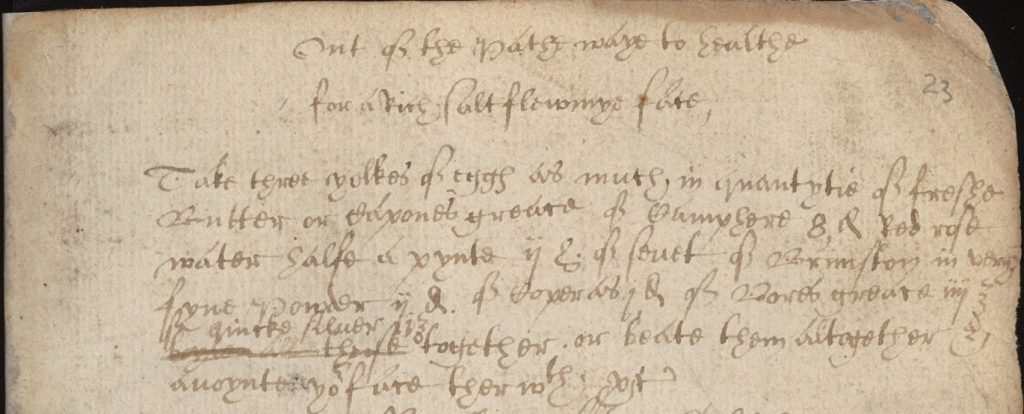
(Cambridge, University Library, MS Dd.6.9, f. 23r)
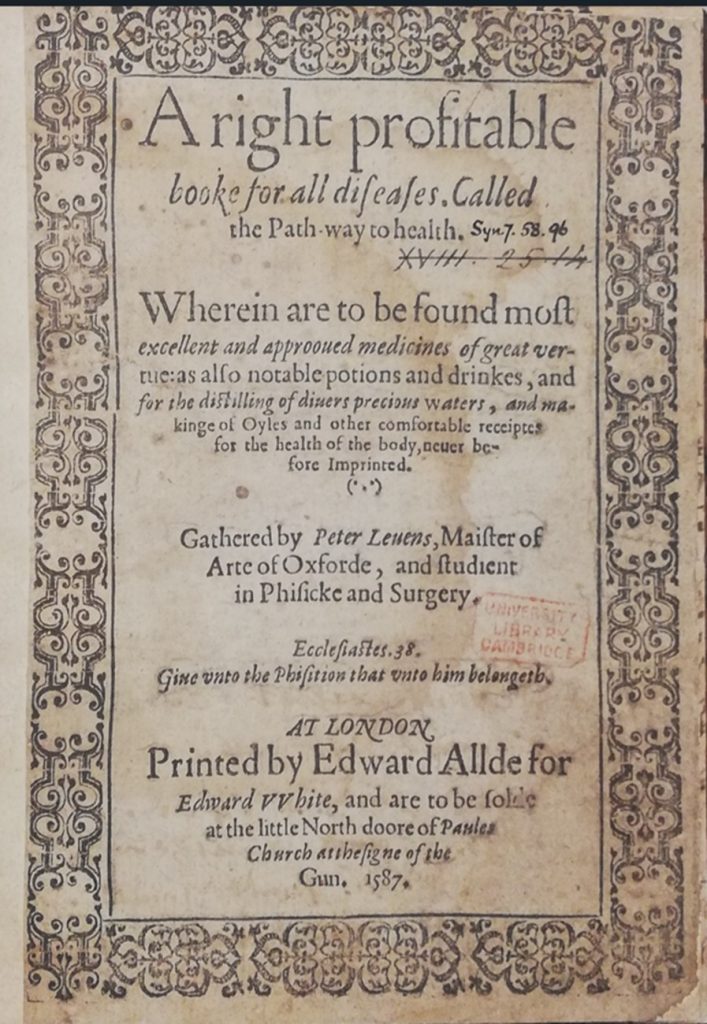
(Cambridge, University Library, Syn.7.58.96)
We can narrow the manuscript’s dating down to roughly a decade using two final pieces of evidence. These concern references to sources from which medical recipes were copied into our manuscript. In one instance, the scribe indicates that they have taken recipes ‘Out of the Pathe waye to healthe’. This almost certainly refers to A Right Profitable Booke for All Disseases Called The Pathway to Health (London: White, 1587) by the medical writer Peter Levens (fl. 1587). At another point, the scribe simply refers to their source as ‘Banesteres antidorye’. This must be An Antidotarie Chyrurgicall Containing Great Varietie and Choice of All Sorts of Medicines That Commonly Fal into the Chyrurgions Use (London: Orwin, 1589) by the anatomist and surgeon John Banister (1533–1610). Since these are the latest datable sources in the manuscript, it seems likely that the manuscript was copied in the 1590s.
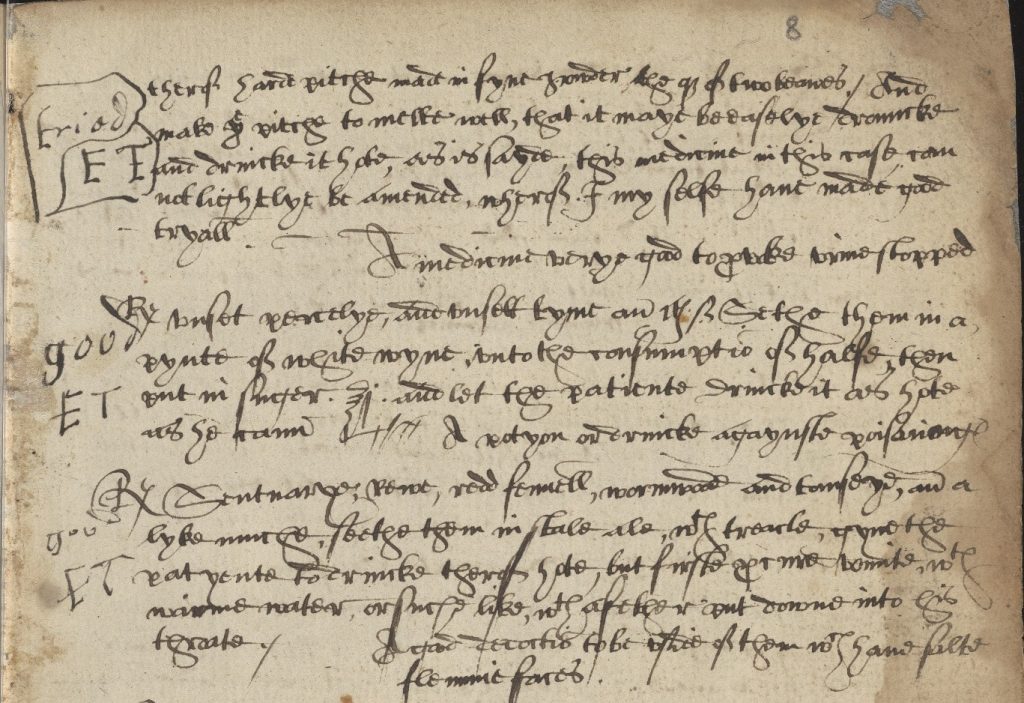
(Cambridge University Library, MS Dd.6.9, f. 8r)
With the new late sixteenth-century dating for our manuscript, it becomes easier to understand signs that its contents were actively consulted in the late sixteenth and early seventeenth century. One early owner evidently viewed the manuscript’s contents as useful for their own medical practice. Not only did they add their initials ‘E.T.’ in the margins next to medical recipes throughout the manuscript, but they occasionally also noted that they had ‘tried’ them or had found them ‘good’. Clearly, they recognised that the manuscript’s recipes reflected recent medical developments and insights that were still very much current in their own times.
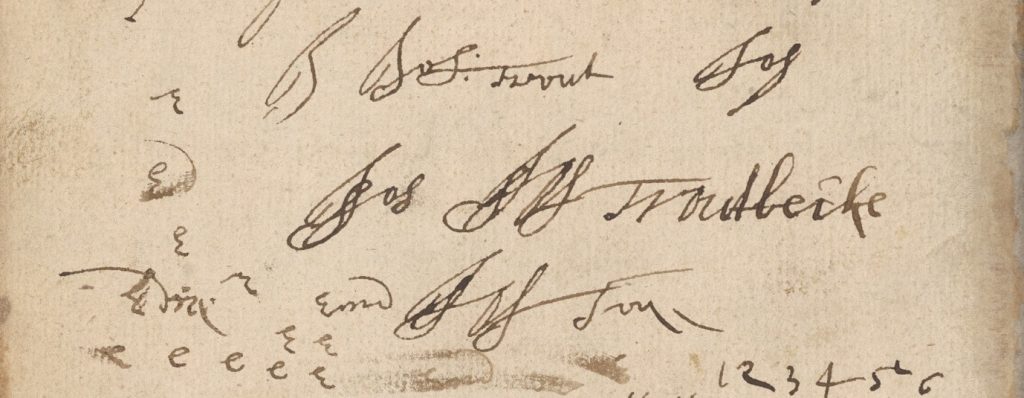
(Cambridge, University Library, MS Dd.6.9, f. 55v)
An important clue for the identity of ‘E.T.’ is the name ‘John Troutbeck’ that a seventeenth-century owner has written thrice on an originally blank page. While this name has previously remained unnoticed, he may well be John Troutbeck (1612–1684), son of Edmund Troutbeck (d. 1659), surgeon of Hope Hall in Bramham, West Yorkshire, who briefly studied in Cambridge in the 1630s, served as a surgeon to the Parliamentarian forces in the English Civil War in the 1640s and 1650s, and later under Samuel Pepys in the Second Anglo-Dutch War (1665–1667). As a reward for promoting the Restoration, he was appointed surgeon in ordinary supernumerary to Charles II in 1660, physician general to the fleet in 1666, and was granted the degree of Doctor of Medicine from the University of Cambridge in 1661 (on him, see Peter Elmer, Medicine in an Age of Revolution (2023), pp. 351-352).

(Cambridge, University Library, MS Dd.6.9, f. 55v)
What gives weight to the identification of the John Troutbeck who inscribed his name with the Yorkshire surgeon, is the fact that the same Troutbeck also copied the name of an army officer who probably was active in the Civil War immediately above his own. It concerns a draft of the opening of a letter to a certain ‘Mr John Daniell’ who is addressed with the title ‘Captaine’. While he cannot be identified with certainty, he could be John Daniell junior, son of John Daniell of Daresbury, Cheshire, who was Captain of the Parliamentary forces in Cheshire in 1644 (on him, see The Cromwell Association Online Directory of Parliamentarian Army Officers, ed. Stephen K. Roberts (2017)).
We now have sufficient details to create a speculative early history for the manuscript: after it was compiled in the 1590s, it soon came into the hands of Edmund Troutbeck (‘E.T.’). Edmund actively annotated recipes that he had used in his medical practice, and subsequently passed the manuscript on to his son John. We do not know how John used the manuscript, but it is plausible that he consulted it during his service in the Civil War (he may have found its tract on treating gunshot wounds particularly useful). It is unknown exactly how and when the manuscript was acquired by Cambridge University Library but given John’s connections with Cambridge, it is feasible that he donated it to the library. And thus our reconstruction of the manuscript’s earliest history concludes. Having ‘removed’ it from the Middle Ages and correctly placed it in the late Elizabethan period, it is hoped that scholars can shed further light on its history and contents.
